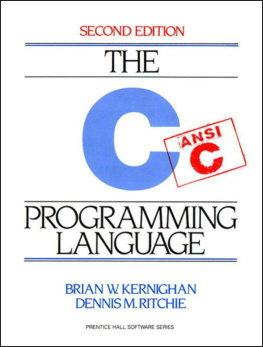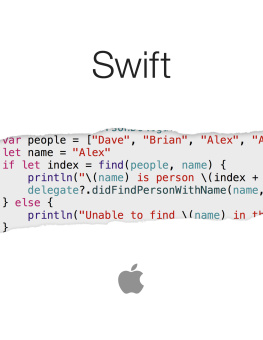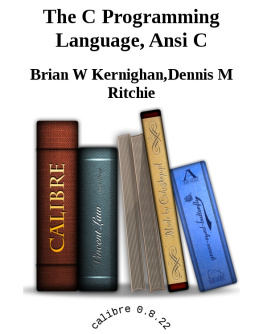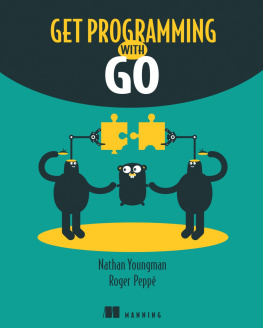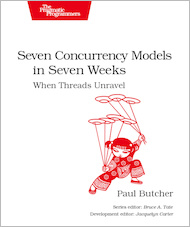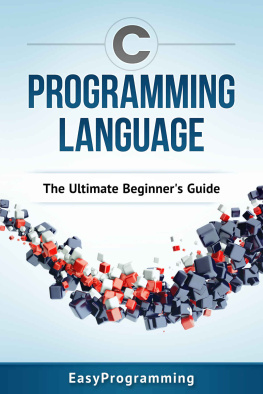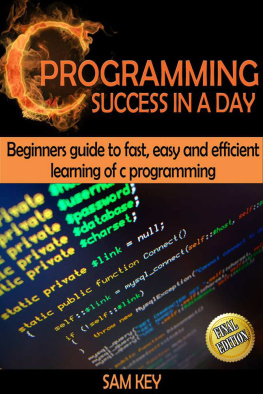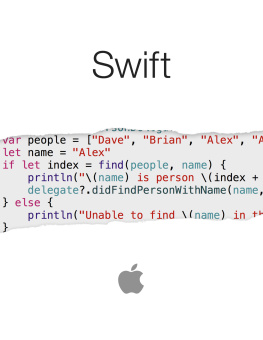Kerninghan Brian W. - The C programming language
Here you can read online Kerninghan Brian W. - The C programming language full text of the book (entire story) in english for free. Download pdf and epub, get meaning, cover and reviews about this ebook. City: Englewood Cliffs, year: 1998;1988, publisher: Pearson Education;Prentice Hall, genre: Romance novel. Description of the work, (preface) as well as reviews are available. Best literature library LitArk.com created for fans of good reading and offers a wide selection of genres:
Romance novel
Science fiction
Adventure
Detective
Science
History
Home and family
Prose
Art
Politics
Computer
Non-fiction
Religion
Business
Children
Humor
Choose a favorite category and find really read worthwhile books. Enjoy immersion in the world of imagination, feel the emotions of the characters or learn something new for yourself, make an fascinating discovery.

- Book:The C programming language
- Author:
- Publisher:Pearson Education;Prentice Hall
- Genre:
- Year:1998;1988
- City:Englewood Cliffs
- Rating:5 / 5
- Favourites:Add to favourites
- Your mark:
- 100
- 1
- 2
- 3
- 4
- 5
The C programming language: summary, description and annotation
We offer to read an annotation, description, summary or preface (depends on what the author of the book "The C programming language" wrote himself). If you haven't found the necessary information about the book — write in the comments, we will try to find it.
The C programming language — read online for free the complete book (whole text) full work
Below is the text of the book, divided by pages. System saving the place of the last page read, allows you to conveniently read the book "The C programming language" online for free, without having to search again every time where you left off. Put a bookmark, and you can go to the page where you finished reading at any time.
Font size:
Interval:
Bookmark:
Second Edition
Brian W. Kernighan Dennis M. Ritchie
AT&T Bell Laboratories
Murray Hill, New Jersey

Prentice Hall PTR, Upper Saddle River, New Jersey 07458
Library of Congress Cataloging-in-Publication Data
Kernighan, Brian W.
The C programming language.
Includes index.
1. C (Computer program language) I. Ritchie,
Dennis M. II. Title.
QA76.73.C15K47 1988 005.133 88-5934
ISBN 0-13-110370-9
ISBN 0-13-110362-8 (pbk.)
Copyright 1988, 1978 by Bell Telephone Laboratories, Incorporated.

Published by Prentice Hall PTR
Prentice-Hall, Inc.
Upper Saddle River, NJ 07458
All rights reserved. No part of this publication may be reproduced, stored in a retrieval system, or transmitted, in any form or by any means, electronic, mechanical, photocopying, recording, or otherwise, without the prior written permission of the publisher. Printed in the United States of America. Published simultaneously in Canada.
UNIX is a registered trademark of AT&T.
This book was typeset (pictbleqntroff -ms) in Times Roman and Courier by the authors, using an Autologic APS-5 phototypesetter and a DEC VAX 8550 running the 9th Edition of the UNIX operating system.
Prentice Hall Software Series
Brian Kernighan, Advisor
ISBN 0-13-110362-8
Text printed in the United States on recycled paper at Courier in Westford, Massachusetts.
Forty-ninth printing, January 2012
ISBN 0-13-110362-8 {PBK}
ISBN 0-13-110370-9
Prentice-Hall International (UK) Limited, London
Prentice-Hall of Australia Pty. Limited, Sydney
Prentice-Hall of Canada, Inc., Toronto
Prentice-Hall Hispanoamericana, S. A., Mexico
Prentice-Hall of India Private Limited, New Delhi
Prentice-Hall of Japan, Inc., Tokyo
Prentice-Hall Asia Pte. Ltd., Singapore
Editora Prentice-Hall do Brasil, Ltda., Rio de Janeiro
The computing world has undergone a revolution since the publication of The C Programming Language in 1978. Big computers are much bigger, and personal computers have capabilities that rival the mainframes of a decade ago. During this time, C has changed too, although only modestly, and it has spread far beyond its origins as the language of the UNIX operating system.
The growing popularity of C, the changes in the language over the years, and the creation of compilers by groups not involved in its design, combined to demonstrate a need for a more precise and more contemporary definition of the language than the first edition of this book provided. In 1983, the American National Standards Institute (ANSI) established a committee whose goal was to produce an unambiguous and machine-independent definition of the language C, while still retaining its spirit. The result is the ANSI standard for C.
The standard formalizes constructions that were hinted at but not described in the first edition, particularly structure assignment and enumerations. It provides a new form of function declaration that permits cross-checking of definition with use. It specifies a standard library, with an extensive set of functions for performing input and output, memory management, string manipulation, and similar tasks. It makes precise the behavior of features that were not spelled out in the original definition, and at the same time states explicitly which aspects of the language remain machine-dependent.
This second edition of The C Programming Language describes C as defined by the ANSI standard. Although we have noted the places where the language has evolved, we have chosen to write exclusively in the new form. For the most part, this makes no significant difference; the most visible change is the new form of function declaration and definition. Modern compilers already support most features of the standard.
We have tried to retain the brevity of the first edition. C is not a big language, and it is not well served by a big book. We have improved the exposition of critical features, such as pointers, that are central to C programming. We have refined the original examples, and have added new examples in several chapters. For instance, the treatment of complicated declarations is augmented by programs that convert declarations into words and vice versa. As before, all examples have been tested directly from the text, which is in machine-readable form.
is a concise summary of the changes from the original version.
As we said in the preface to the first edition, C wears well as ones experience with it grows. With a decade more experience, we still feel that way. We hope that this book will help you to learn C and to use it well.
We are deeply indebted to friends who helped us to produce this second edition. Jon Bentley, Doug Gwyn, Doug McIlroy, Peter Nelson, and Rob Pike gave us perceptive comments on almost every page of draft manuscripts. We are grateful for careful reading by Al Aho, Dennis Allison, Joe Campbell, G. R. Emlin, Karen Fortgang, Allen Holub, Andrew Hume, Dave Kristol, John Linderman, Dave Prosser, Gene Spafford, and Chris Van Wyk. We also received helpful suggestions from Bill Cheswick, Mark Kernighan, Andy Koenig, Robin Lake, Tom London, Jim Reeds, Clovis Tondo, and Peter Weinberger. Dave Prosser answered many detailed questions about the ANSI standard. We used Bjarne Stroustrups C++ translator extensively for local testing of our programs, and Dave Kristol provided us with an ANSI C compiler for final testing. Rich Drechsler helped greatly with typesetting.
Our sincere thanks to all.
Brian W. Kernighan
Dennis M. Ritchie
C is a general-purpose programming language which features economy of expression, modern control flow and data structures, and a rich set of operators. C is not a very high level language, nor a big one, and is not specialized to any particular area of application. But its absence of restrictions and its generality make it more convenient and effective for many tasks than supposedly more powerful languages.
C was originally designed for and implemented on the UNIX operating system on the DEC PDP-11, by Dennis Ritchie. The operating system, the C compiler, and essentially all UNIX applications programs (including all of the software used to prepare this book) are written in C. Production compilers also exist for several other machines, including the IBM System/370, the Honeywell 6000, and the Interdata 8/32. C is not tied to any particular hardware or system, however, and it is easy to write programs that will run without change on any machine that supports C.
This book is meant to help the reader learn how to program in C. It contains a tutorial introduction to get new users started as soon as possible, separate chapters on each major feature, and a reference manual. Most of the treatment is based on reading, writing and revising examples, rather than on mere statements of rules. For the most part, the examples are complete, real programs, rather than isolated fragments. All examples have been tested directly from the text, which is in machine-readable form. Besides showing how to make effective use of the language, we have also tried where possible to illustrate useful algorithms and principles of good style and sound design.
Font size:
Interval:
Bookmark:
Similar books «The C programming language»
Look at similar books to The C programming language. We have selected literature similar in name and meaning in the hope of providing readers with more options to find new, interesting, not yet read works.
Discussion, reviews of the book The C programming language and just readers' own opinions. Leave your comments, write what you think about the work, its meaning or the main characters. Specify what exactly you liked and what you didn't like, and why you think so.


